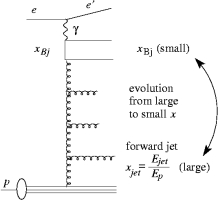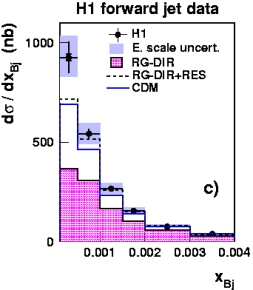Forward Jet Production in Deep Inelastic Scattering at HERA
Forward Jet Production in Deep Inelastic Scattering at HERA
|
The hadronic final state in deep inelastic scattering
offers a rich field of research for QCD phenomena. This includes studies of
hard parton emissions which result in well defined jets, perturbative effects
responsible for multiple gluon emissions and the non-perturbative hadronisation
process.
 HERA has extended the available region in the Bjorken scaling variable,
x_Bj, down to values of x_Bj ~ 10-4, for values of the four momentum
transfer squared, Q², larger than a few GeV², where perturbative calculations
in QCD are expected to be valid. At these low x_Bj values, a parton in the
proton can induce a QCD cascade, consisting of several subsequent parton emissions,
before eventually an interaction with the virtual photon takes place (see
figure). The large phase space available at low x_Bj makes the production
of forward jets a particularly interesting process for the study of parton
dynamics, since jets emitted close to the proton direction lie well away
in rapidity from the photon end of the evolution ladder.
HERA has extended the available region in the Bjorken scaling variable,
x_Bj, down to values of x_Bj ~ 10-4, for values of the four momentum
transfer squared, Q², larger than a few GeV², where perturbative calculations
in QCD are expected to be valid. At these low x_Bj values, a parton in the
proton can induce a QCD cascade, consisting of several subsequent parton emissions,
before eventually an interaction with the virtual photon takes place (see
figure). The large phase space available at low x_Bj makes the production
of forward jets a particularly interesting process for the study of parton
dynamics, since jets emitted close to the proton direction lie well away
in rapidity from the photon end of the evolution ladder.
In the measurement various constraints are applied,
which suppress contributions to the parton evolution described by the conventional
equations (DGLAP) and enhance the sensitivity to other parton dynamics.
In inclusive forward jet production this is expected to be the case when
the transverse momentum squared of the jet and the photon virtuality are
of similar order. For the so called BFKL dynamics the fractional momentum
carried by the partons are ordered through the parton ladder.
 The inclusive forward jet cross-section as a function of x_Bj is shown to
the right. The data is compared to various QCD based models. The conventional
DGLAP calculations (RG-DIR), in which the partons in the parton ladder are
ordered in virtuality, are not sufficient to describe the data. Models which
break this ordering in virtuality (CDM and RG-DIR+RES) come significantly
closer to the data.
The inclusive forward jet cross-section as a function of x_Bj is shown to
the right. The data is compared to various QCD based models. The conventional
DGLAP calculations (RG-DIR), in which the partons in the parton ladder are
ordered in virtuality, are not sufficient to describe the data. Models which
break this ordering in virtuality (CDM and RG-DIR+RES) come significantly
closer to the data.
The results are also presented as triple differential
cross-sections versus x_Bj, in bins of Q² and the squared transverse momentum
of the forward jet. More exclusive final states, like those containing a
di-jet system in addition to the forward jet (`2+forward jet'), provide a
further handle to control the parton dynamics, and the cross sections have
been measured for different rapidity separations between the three jets.
The measurements are compared to LO and NLO di-jet calculations (DISENT)
and three-jet calculations (NLOJET++), as well as different phenomenological
QCD based models (CASCADE, ARIADNE with CDM, RAPGAP and RAPGAP-resolved).
The results demonstrate that an accurate description
of the radiation pattern at small x_Bj requires the introduction of terms
beyond those included in the DGLAP direct approximation. Higher order parton
emissions contribute noticeably to the cross-section. Further it is observed
that calculations which include breaking of the transverse momentum ordering,
such as CDM and the resolved photon model, provide a better description of
the data. The inclusive forward jet measurements are equally well described by CDM and the DGLAP resolved model,
and are obviously not sensitive to differences between the models. However,
in the more exclusive measurement of `2+forward jet' events a clear differentiation
of the models is obtained since, in contrast to CDM, the DGLAP resolved
model fails to describe the data.
 HERA has extended the available region in the Bjorken scaling variable,
x_Bj, down to values of x_Bj ~ 10-4, for values of the four momentum
transfer squared, Q², larger than a few GeV², where perturbative calculations
in QCD are expected to be valid. At these low x_Bj values, a parton in the
proton can induce a QCD cascade, consisting of several subsequent parton emissions,
before eventually an interaction with the virtual photon takes place (see
figure). The large phase space available at low x_Bj makes the production
of forward jets a particularly interesting process for the study of parton
dynamics, since jets emitted close to the proton direction lie well away
in rapidity from the photon end of the evolution ladder.
HERA has extended the available region in the Bjorken scaling variable,
x_Bj, down to values of x_Bj ~ 10-4, for values of the four momentum
transfer squared, Q², larger than a few GeV², where perturbative calculations
in QCD are expected to be valid. At these low x_Bj values, a parton in the
proton can induce a QCD cascade, consisting of several subsequent parton emissions,
before eventually an interaction with the virtual photon takes place (see
figure). The large phase space available at low x_Bj makes the production
of forward jets a particularly interesting process for the study of parton
dynamics, since jets emitted close to the proton direction lie well away
in rapidity from the photon end of the evolution ladder.  The inclusive forward jet cross-section as a function of x_Bj is shown to
the right. The data is compared to various QCD based models. The conventional
DGLAP calculations (RG-DIR), in which the partons in the parton ladder are
ordered in virtuality, are not sufficient to describe the data. Models which
break this ordering in virtuality (CDM and RG-DIR+RES) come significantly
closer to the data.
The inclusive forward jet cross-section as a function of x_Bj is shown to
the right. The data is compared to various QCD based models. The conventional
DGLAP calculations (RG-DIR), in which the partons in the parton ladder are
ordered in virtuality, are not sufficient to describe the data. Models which
break this ordering in virtuality (CDM and RG-DIR+RES) come significantly
closer to the data.